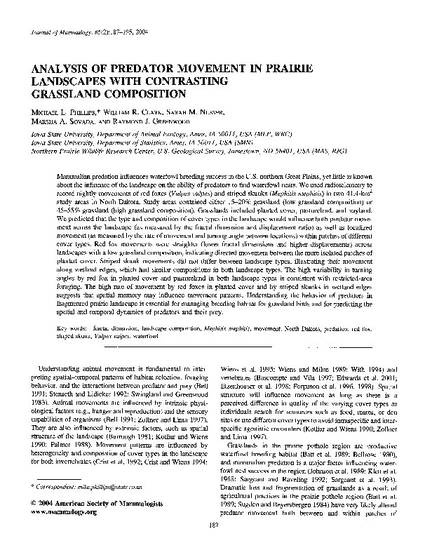
Mammalian predation influences waterfowl breeding success in the U.S. northern Great Plains, yet little is known aboutt he influenceo f the landscapeo n the ability of predatorst o find waterfowln ests. We used radiotelemetryt o record nightly movements of red foxes (Vulpes vulpes) and striped skunks (Mephitis mephitis) in two 41.4-kn2 study areas in North Dakota. Study areas contained either 15-20% grassland (low grassland composition) or 45-55% grassland (high grassland composition). Grasslands included planted cover, pastureland, and hayland. We predicted that the type and composition of cover types in the landscape would influence both predator movement across the landscape (as measured by the fractal dimension and displacement ratio) as well as localized movement (as measured by the rate of movement and turning angle between locations) within patches of different cover types. Red fox movements were straighter (lower fractal dimensions and higher displacements) across landscapes with a low grassland composition, indicating directed movement between the more isolated patches of planted cover. Striped skunk movements did not differ between landscape types, illustrating their movement along wetland edges, which had similar compositions in both landscape types. The high variability in turning angles by red fox in planted cover and pastureland in both landscape types is consistent with restricted-area foraging. The high rate of movement by red foxes in planted cover and by striped skunks in wetland edges suggests that spatial memory may influence movement patterns. Understanding the behavior of predators in fragmented prairie landscape is essential for managing breeding habitat for grassland birds and for predicting the spatial and temporal dynamics of predators and their prey.
Available at: http://works.bepress.com/sarah_nusser/9/

This article is from Journal of Mammology 85 (2004): 187–195.